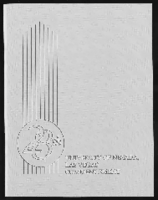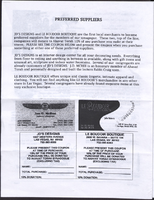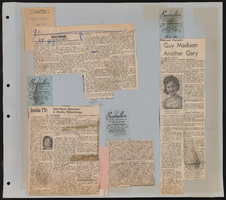Search the Special Collections and Archives Portal
Search Results
The Front Page, approximately 1927 to 1939
Level of Description
Scope and Contents
The Front Page sub-series (approximately 1927-1939) is comprised of materials pertaining to the production process of The Caddo Company's April 4, 1931 release of The Front Page. The sub-series contains advertising and publicity, administrative, financial, legal, and production and direction, and story development records. Director Lewis Milestone, along with editor Duncan Mansfield and writers Ben Hecht, Charles MacArthur, and Bartlett Cormack helped the film earn Academy Awards nominations for Best Director and Best Picture in 1929. The black-and-white photographic prints and negatives, primarily attributed to Newton Hopcroft, depict set and production stills of the principal and supporting cast and locations in the film.
Advertising and publicity records include newspaper clippings detailing the film’s release, articles of local advertising campaigns, and publicity stills of principal and supporting cast members. Administrative records include correspondence pertaining to the editing, censorship, and distribution of the film, as well as shipping receipts. Legal records include supporting actor and domestic distribution contracts. Production and direction records include production stills of principal and supporting cast, interior and exterior sets, and a sound and production daily report ledger. The story development records include production scripts, as well as cutting continuities and dialogue scripts for domestic and international releases.
Archival Collection
Pagination
- Previous page ‹‹
- Page 10
Archival Component

Transcript of interview with Jim Olson by Stefani Evans and Claytee D. White, February 2, 2017
Date
Archival Collection
Description
As Las Vegas native Jim Olson looks back on his law career, he keeps returning to the case that gouged a sooty scar on his memory, altered legal practice and technology in Southern Nevada, captured the world's imagination, and changed international building codes-the MGM Grand Hotel and Casino fire of November 21, 1980, that killed 85 people and took eight years to litigate. Olson became involved with the litigation because his firm, Cromer, Barker, and Michaelson, represented the MGM Grand's insurance company, INA, Insurance Company of North America. Juggling thousands of claims, Olson ended up working with the MGM's corporate counsel in Los Angeles, a legal firm in Denver, Lloyd's of London, and a special master; renting additional office space for taking depositions; hiring graveyard-shift transcribers, and purchasing the legal world's latest technological marvel-a fax machine. As a first grader, five-year-old Jim was known to walk home during the school day whenever the St. Joseph nuns scared him. As an attorney whose career path was inspired by Perry Mason and augmented by his argumentative streak, Jim offers insights into litigation about some of Southern Nevada's most iconic buildings, signs, and spaces. In this interview, he recalls his mentors, Al Gunderson, George Cromer, Bill Barker, and Kent Michaelson. He talks of construction defect cases including his first MGM Grand litigation, in which his firm represented the architect, Martin Stern, when faulty siding fell off the building, and the 1994 lawsuits that followed when the top of the newly constructed, 365-foot Las Vegas Hilton sign blew down in a windstorm. He shares tales of legendary fellow attorney Mike Hines and his annual Nevada Bar Association parties on the Mike Hines Ranch, and he speaks to litigation between Hank Greenspun, Howard Hughes, and Hughes Tool Company.
Text

University of Nevada, Las Vegas (UNLV) 28th commencement program
Date
Archival Collection
Description
Commencement program from University of Nevada, Las Vegas Commencement Programs and Graduation Lists (UA-00115).
Text

Meeting minutes for Consolidated Student Senate, University of Nevada, Las Vegas, August 1, 1978
Date
Archival Collection
Description
Text

Transcript of an interview with Chris Ramirez by Wendy Starkweather on October 2, 2013
Date
Archival Collection
Description
Text


